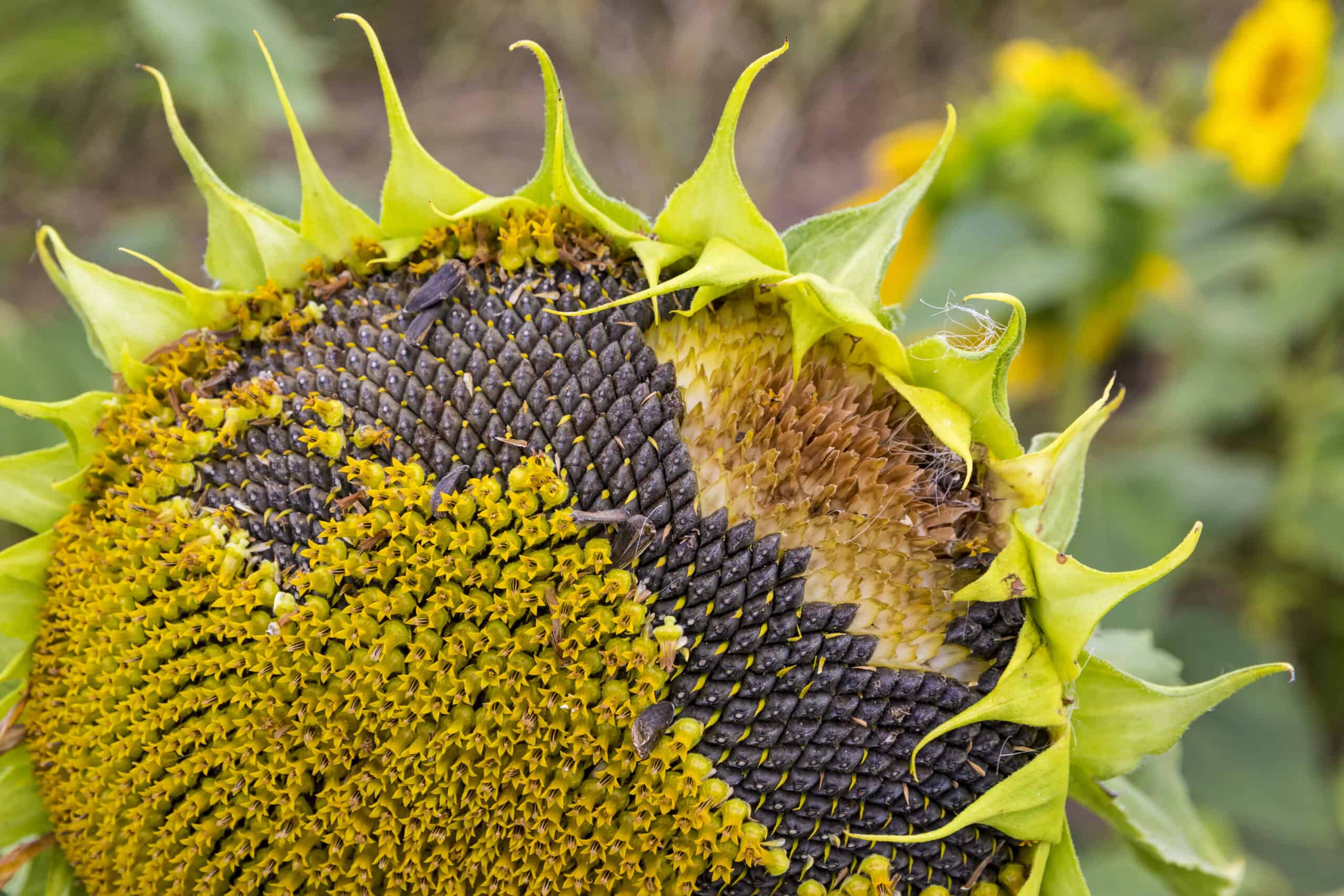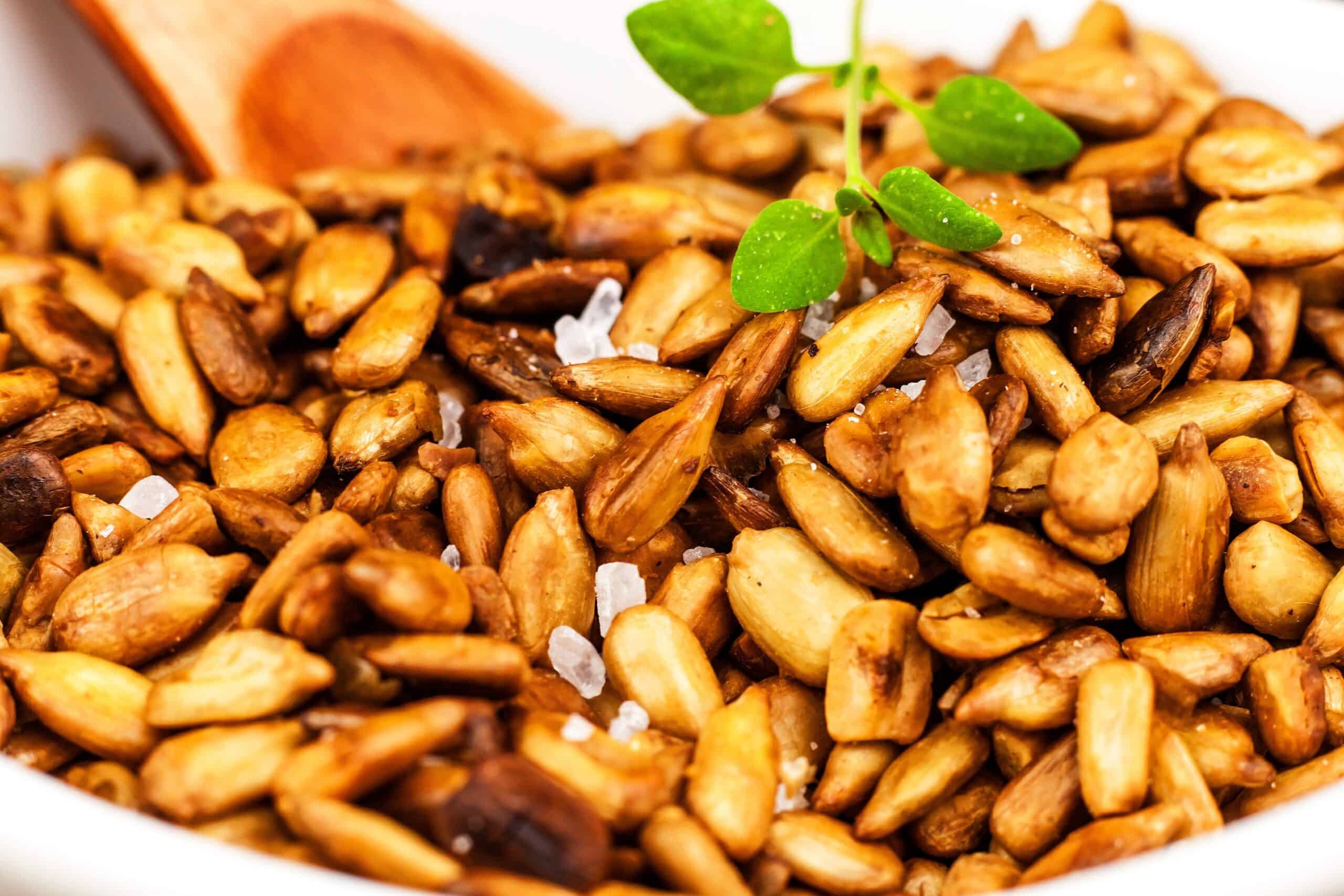Sunflower seeds have a pleasant, nutty flavor and a crunchy texture that makes them a welcome and simple addition sprinkled on salads, sandwiches, vegetable dishes, and yogurt as well as mixed into stuffings and granola.
Ground sunflower seeds can be combined with flour to make cakes, cookies, muffins, pancakes, and bread.

Lightly toasted sunflower seeds are a tasty snack for eating out of hand. Unshelled seeds also can be roasted and salted then eaten from the shells as a snack.
Favorite sunflower recipe
How to choose sunflowers
- Seeds should be firm and glossy.
- Avoid yellowish seeds that are no longer fresh.
- The sunflower inflorescence can be cut from the stalk as soon as the backside of the seed head begins to turn from green to brown. The seeds can be harvested by hanging the heads in a dry, airy place until the seeds dry in about a week. Then the seeds can be rubbed off of the dried heads.

Ways to prepare sunflowers
- To shell sunflowers by hand requires time. Sunflowers also can be shelled in a seed mill or an electric mixer.
- To shell sunflowers with an electric mixer, pour a small number of shells into a bowl and turn the mixer on for a few seconds; then separate the seeds from the shells in the water. Some seeds will be crushed using this method. Strain the seeds as quickly as possible and dry them.
- Toasting will enhance the flavor of sunflower seeds. Cook them in an ungreased skillet over medium heat, stirring frequently for about 5 minutes or until golden brown. Seeds also can be toasted in a single layer on a cookie sheet in a 350ºF (176ºC) oven for 5 to 7 minutes until they brown slightly.
- Seeds used as a topping for baked goods need not be toasted because the oven will do the job. When sunflower seeds combine with baking soda in baked goods they take on a blue-green tinge that is not aesthetically pleasing.
- You can also bake sunflower seeds for 10 minutes in the oven at 200ºF (93ºC). Stir occasionally. Once baked coat the seeds with a small amount of oil so that salt will stick to them.
- To chop or dice sunflower seeds, slightly moisten the seeds with a little oil then chop them. They will not fly away.
- Use sunflower seed oil for dressing, sautéing, and roasting. Oil heated beyond 340ºF (170ºC) does not withstand heating and will burn.

How to store sunflowers
- Keep unshelled sunflower seeds in a glass jar in a cool, dark, dry place.
- Shelled or ground seeds should be refrigerated and used within one month.
- Shelled and ground seeds can be frozen.
Sunflower nutrition
- Sunflower seeds are rich in vitamins B and E, calcium, phosphorus, and iron.
- One ounce of sunflower seeds supplies 76 percent of the daily requirement for vitamin E—the antioxidant vitamin.
Get to know sunflowers
- The sunflower grows as an annual in most temperate regions and as a perennial plant in tropical regions. Sunflowers can grow from 3 to 12 feet (1-3.7 m) tall depending upon the variety. They have coarse, heart-shaped leaves.
 The sunflower blossom is an inflorescence or collection of thousands of small, tubular flowers arranged side by side to form row after row of circles radiating from the center. This flat disc is surrounded by yellow petals. (Not all sunflower petals are yellow; some are orange, red, or copper-colored.) Each flower produces grayish-green or black seeds depending on the species enclosed in thin gray or black shells some with black and white stripes. The flower heads or discs can grow to 12 inches in diameter.
The sunflower blossom is an inflorescence or collection of thousands of small, tubular flowers arranged side by side to form row after row of circles radiating from the center. This flat disc is surrounded by yellow petals. (Not all sunflower petals are yellow; some are orange, red, or copper-colored.) Each flower produces grayish-green or black seeds depending on the species enclosed in thin gray or black shells some with black and white stripes. The flower heads or discs can grow to 12 inches in diameter.- The sunflower originated in Mexico and Peru. Native Americans have used various parts of the plant—the seeds, stems, flowers, and roots–for more than 5,000 years.
- The Spanish introduced the sunflower in the Old World in the fifteenth century.
Russia and other countries of the former Soviet Union are the leading producers of sunflowers today. - The botanical name for the sunflower is Helianthus, a conflation of the Greek words for sun, helios, and flower, anthos.
The botanical name of the sunflower is Helianthus annuus.
Articles of interest:
Best Herbs for Container Growing
Garden Planning Books at Amazon:
- Vegetable Garden Almanac & Planner
- Kitchen Garden Grower’s Guide Vegetable Encyclopedia
- Vegetable Garden Grower’s Guide
- Tomato Grower’s Answer Book
More kitchen tips:
Bring your harvest to the table. Kitchen prep tips and easy recipes for the vegetables you grow. Click below for vegetable prep and recipes you can use now.
- Almonds
- Apples
- Apricot
- Aprium
- Artichoke
- Arugula
- Asparagus
- Avocado
- Bamboo Shoots
- Banana
- Basil
- Beans, Dried
- Beans. Long
- Beans, Shell
- Beans, Snap
- Beets
- Bitter Melon
- Blackberry
- Bok Choy
- Broccoli
- Broccoli Raab
- Brussels Sprouts
- Cabbage
- Cardoon
- Carrots
- Cauliflower
- Celeriac
- Celery
- Chard
- Chayote Squash
- Cherimoya
- Cherries
- Chestnut
- Chickpea
- Chinese Cabbage
- Chives
- Cilantro
- Citron
- Clementine
- Collards
- Coriander
- Corn, Sweet
- Corn, Baby
- Corn Salad, Mache
- Cranberry
- Cress
- Cucumber
- Daikon
- Dandelion
- Dill
- Eggplant
- Endive, Belgian
- Endive and Escarole
- Fava Beans
- Fig
- Florence Fennel
- Garlic
- Ginger
- Grapefruit
- Grapes
- Guava
- Horseradish
- Jerusalem Artichoke
- Jicama
- Jujube
- Kale
- Kiwifruit
- Kohlrabi
- Kumquat
- Leeks
- Lemongrass
- Lemons
- Lettuce
- Lime
- Mache (Corn Salad)
- Mandarin Orange
- Mango
- Maple Syrup
- Marjoram
- Melons
- Michihili
- Mint
- Mizuna
- Mushrooms
- Mushrooms, Cremini
- Mustard Greens
- Napa Cabbage
- Nectarine
- Okra
- Olives
- Olive oil
- Onions
- Oranges
- Oregano
- Parsley
- Parsley Root
- Parsnips
- Passion Fruit
- Pawpaw
- Peaches
- Pears
- Peas, Garden Snap
- Peas, Snow
- Pei Tsai
- Peppers, Chili
- Peppers, Sweet
- Persimmon
- Pineapple
- Pineapple Guava
- Plantain
- Plums
- Pluots
- Pomegranate
- Potatoes
- Prickly Pear
- Pumpkin
- Quince
- Radicchio
- Radishes
- Raspberries
- Rosemary
- Rhubarb
- Rutabaga
- Sage
- Salsify
- Sauerkraut
- Savory
- Shallots
- Sorrel
- Spinach
- Squash, Summer
- Squash, Winter
- Strawberries
- Sunchokes
- Sunflower
- Sweet Potato
- Swiss Chard
- Tangerine
- Taro
- Tarragon
- Thyme
- Tomatillo
- Tomato
- Turnip
- Turnip Greens
- Yams


 The sunflower blossom is an inflorescence or collection of thousands of small, tubular flowers arranged side by side to form row after row of circles radiating from the center. This flat disc is surrounded by yellow petals. (Not all sunflower petals are yellow; some are orange, red, or copper-colored.) Each flower produces grayish-green or black seeds depending on the species enclosed in thin gray or black shells some with black and white stripes. The flower heads or discs can grow to 12 inches in diameter.
The sunflower blossom is an inflorescence or collection of thousands of small, tubular flowers arranged side by side to form row after row of circles radiating from the center. This flat disc is surrounded by yellow petals. (Not all sunflower petals are yellow; some are orange, red, or copper-colored.) Each flower produces grayish-green or black seeds depending on the species enclosed in thin gray or black shells some with black and white stripes. The flower heads or discs can grow to 12 inches in diameter.












